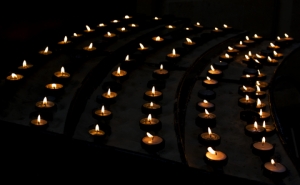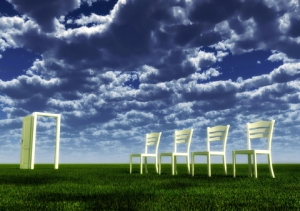A UNITARIAN UNIVERSALIST APOLOGETIC (Part I)
Several months ago, I was casually listening to a piece on NPR when I was stirred, no, perhaps more accurately shaken, out of my decidedly complacent Unitarian Universalist perch. A fellow on the airwaves had lost his religion and feeling very happy and free about it, wanted to share his experience with the rest of us, in the form of a book he had written. Most of it was pretty standard fare-devout Christian background (Episcopalian I believe-but you could fill in the blanks here- I have heard Catholics and Southern Baptists relate similar tales), followed by feelings of disillusionment, first with their particular brand of religion, and then belief all together.
 Callers ranged from those wanting to cajole him back to some sort of faith, ones who wanted to argue, and a much smaller number calling to say, “Good for you.” But when one caller asked if this gentleman had ever visited a Unitarian Universalist church or considered the UU faith, he responded, “Unitarianism is like drinking non-alcoholic beer, what’s the point?”
Callers ranged from those wanting to cajole him back to some sort of faith, ones who wanted to argue, and a much smaller number calling to say, “Good for you.” But when one caller asked if this gentleman had ever visited a Unitarian Universalist church or considered the UU faith, he responded, “Unitarianism is like drinking non-alcoholic beer, what’s the point?”
I suppose if this were just one man’s opinion on a talk radio show, I would have just let it slide. But it’s not. Over the years, my mother has affirmed, “Unitarian Universalism, it’s not even a religion really; it’s more like a philosophy.” My friends ask if we ever even talk about God in our services, never mind Jesus.
Mostly, I get condescending little chuckles at social events and the like, conveying a good-natured tolerance of my folly. Sometimes it’s a small, woeful smile, an “Oh, you’re one of those.” What they mean, of course, is that I am a member of a loosey goosey, Birkenstock wearing, noncommittal, not as legitimate as their faith, only “kind of” a church. And aside from having a liberal bent, I can attest to having none of these attributes.
As a trained theologian who arrived at my faith by a long process which involved both head and heart, I feel compelled to respond to that off-handed comment. To infer that there is no meaningful effect on one’s life and the community or no tangible compass by being a member of the Unitarian Universalist faith is simply wrong. It continues to be perpetuated by the reticence of Unitarians to feel that they are trying to “sell” their faith to anyone combined with the fact that other religions in the U.S. have most successfully evangelized theirs.
It’s a tenaciously held prejudice, a myth propelled by a shroud of misinformation, which I attempt here to dispel. It has become abundantly clear to me that the time has come for someone to defend this little known, oft misunderstood faith. So, following in the tradition of the early Christian Apologists, remembering Justin Martyr, Origen, Tertullian, and Irenaeus, defenders of their young faith amidst an onslaught of skeptics and persecutors, (while unlike them, without the fear of being martyred), I hereby humbly submit a Unitarian Universalist Apology to the mainstream Protestants, fundamentalist Christians, and all strata of Roman Catholics of these United States of America.
Theologically speaking, I am going to climb out on a limb here and state that Unitarianism has been around since the first groups of Christians were meeting to worship God and Jesus in their own physical locations and with their own unique emphasis. This went on for several hundred years in a relatively non confrontational way (amongst the Christians themselves at least) until 320 or so, when the lack of uniformity posed a threat to the social and political order of Constantine I (the first Roman Catholic emperor). His desire was that these “divisions” be quelled.
 Citizens were certainly having heated arguments over who exactly Jesus Christ was, what his relationship with God the Father was, and whether he was God or not. There were a host of variant but equally passionate opinions; there were almost as many ideas about Jesus as there were people to convey them. These discussions were taking place in local shops, at the bakery, the dinner table; it was the topic of the day.
Citizens were certainly having heated arguments over who exactly Jesus Christ was, what his relationship with God the Father was, and whether he was God or not. There were a host of variant but equally passionate opinions; there were almost as many ideas about Jesus as there were people to convey them. These discussions were taking place in local shops, at the bakery, the dinner table; it was the topic of the day.
The debate took on an increasingly ferocious nature as Arius, a priest from Egypt, and his followers (Arians) believed that Jesus was not coeternal with the Father. There was a time that Jesus was not. God was the Eternal One, a Unity unto Himself. The seeds of Unitarianism planted. His opponent, Athanasius, a priest also from Alexandria, hostilely disagreed (an influential predecessor to the development of the doctrine of the Trinity). Not only was Jesus cosubstantial with the Father, so was the Holy Spirit. They all had been around since the beginning of time.
When Constantine demanded coherence and orthodoxy as the Church became an accepted political force, 22 bishops descended upon Nicaea in 325CE to determine an official theology. Athanasius’ theology won the day. Arius was labeled a heretic (318CE) (a sentiment libeled against Unitarians over the ages). He was excommunicated, banished, and many say, finally poisoned.
Open and lively discussions were then funneled from a continuous stream of diverse dialogue to a (one size does not fill all) limit imposing creed. The vague philosophical language being bandied about (substance, cosubstantial, coeternal) were conjured up by the closed circle of bishops and religious authorities. Political power and not spiritual presence was the real motivation for these councils and their formulas.
 Yet the conversation still continues, with heretics still having their say…tomorrow I will share some of the American voices that embraced the Oneness of God and the belief in universal salvation.
Yet the conversation still continues, with heretics still having their say…tomorrow I will share some of the American voices that embraced the Oneness of God and the belief in universal salvation.
Book of the Day– A House for Hope by John Buehrens and Rebecca Ann Parker
Quote from the Book of the Day-“Do you want to know how I believe we are saved?” my grandmother once asked me. “We aren’t saved by Jesus’ death on the cross. People who believe that focus on hocus-pocus and avoid having to live out the teaching of Jesus. We are saved by every person in every time and place that has stood up for what is true in spite of threat. Like Socrates did. Like Jesus did. Like many others have done.”














